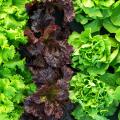Spinach
Spinach, New Zealand Spinach, and Malabar Spinach

Fresh spinach is a popular salad vegetable. A cool-weather green, spinach is adapted to growing in spring, fall, and winter gardens.
Spinach grows best on a well-drained soil rich in organic matter with a pH approaching 7.0. It grows poorly on soils with a pH below 6.0. Spinach plants are shallow-rooted and require adequate soil moisture. Plant spinach seeds 4 to 6 weeks before the last frost in spring and 6 to 8 weeks before the first frost in fall. Soak seeds in water overnight to soften seed coats and hasten germination. With ideal growing conditions, spinach is ready to harvest in 45 to 50 days from planting. Harvest entire plants, individual large outer leaves, or clip plants, leaving about an inch for regrowth.
New Zealand spinach is a hot-weather leafy green. It is not a true spinach, but the tender young shoot tips are used in similar ways. It grows rapidly, has many branches, and prefers a well-drained loamy soil, rich in organic matter. Being a hot-weather plant, the seeds of New Zealand spinach should not be planted until the soil is warm. Soak seed in water overnight before planting to aid germination. Space plants 12 to 18 inches apart in the garden row. Side-dress plants with a little nitrogen fertilizer every 4 to 6 weeks.
Malabar spinach is a tropical, vining plant that does best in hot, humid weather. Easily grown from seed, the plant makes an attractive vine that should be trellised to keep it off the ground. There are two leaf types, red and green. Individual leaves or the tender young shoot tips can be used as a hot-weather spinach substitute.
Varieties
- Chesapeake—hybrid; semi-savoy; bolts rapidly; large, upright plant; overwinters; recommended for fall planting.
- Dixie Market—compact, upright plant; savoyed; recommended for fall, winter, and spring planting.
- Long Standing Bloomsdale—large; savoy leaf; semi-upright plant; recommended for spring planting.
- Melody—hybrid; semi-savoy; upright plant; recommended for early spring and fall planting; AAS 1977.
- Skookum—hybrid; early; dark green; semi-savoy leaf; upright; resistant to downy mildew.
Publications
News
Did you know yellow squash is in the pumpkin family and are 95 percent water?
Tomatoes are a popular crop, both for commercial growers and home gardeners. Even the best tomato growers run into problems along the way! We put together a simple, easy-to-follow guide to help you spot a few of the most common tomato troubles gardeners see.
Did you know lettuce was one of the first vegetables brought to America by Christopher Columbus? What a great fun fact!




